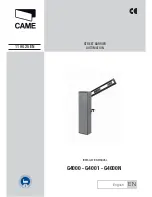
20
-
VIRGO Ver. 03
D811415_03
INSTALLATION MANUAL
ENGLISH
IMPORTANT NOTE: ATTACH THE ADH ESIVE KEY LABEL TO THE
FIRST MEMORISED TRANSMITTER (MASTER).
In the case of manual programming, the first transmitter assigns the key
code to the receiver; this code is necessary in order to carry out subsequent
cloning of the radio transmitters.
11) RADIO-TRANSMITTER CLONING
Rolling-code cloning / Fixed-code cloning
Make reference to the UNIRADIO Instructions and the CLONIX Programming
Guide.
11.1) ADVANCED PROGRAMMING: COLLECTIVE RECEIVERS
Make reference to the UNIRADIO Instructions and the CLONIX Programming
Guide.
16) LIMIT SWITCH ADJUSTMENT (Fig.12)
•
Identify the opening and closing limit switches (FC1 and FC2) taking into
account that:
FC1
corresponds the
CLOSING
limit switch
FC2
corresponds the
OPENING
limit switch.
•
With the gate completely closed or opened, rotate the corresponding
cam until the relevant limit microswitch is heard being tripped, then lock
the cam into position by means of the appropriate screws.
•
Check that the limit switches are triggered correctly, by initiating a few
complete motor-driven opening and closing cycles.
•
If the “lock hold” logic is set to ON in the LINX panel, the leaf continues
its stroke for about 0,5 seconds, in order to ensure stability and perfect
leaf stopping against the end-of-stroke backstops.
17) EMERGENCY MANOEUVRE (Fig.19)
In the case where the power supply is off, or any faults are present, the
manual emergency manoeuvre can be carried out by operating the external
release lever (Fig.1 ref.”S”).
1) Insert the release key and turn it clockwise (Fig.19 ref.”1”).
2) Move lever “S” until the lock is released (Fig.19 ref.”2”).
3) Keep the lever in the release position by turning the key clockwise
(Fig.19 ref.”3”).
4) Push the leaf slowly to open or close the gate.
To reactivate motor-driven operation, turn the key clockwise to free the
lever from its released position, then return it to its initial position for normal
operation.
18) MANUAL WIRE RELEASE DEVICE (Fig.13)
The manual emergency release can be operated by a wire device:
-
Take all the metal cable out of the sheath and insert it into the release
lever (Fig.13 - “L”).
-
Lock the sheath and suitably adjust its position by means of the
appropriate screw (Fig.13 - “V”).
-
The cover is provided with a section to be torn off for the sheath to go
through.
-
For further information, refer to the specific instructions for the release
device.
19) VIRGO BAT KIT INSTALLATION
-
Fix the SBS board on the back of the panel box by means of a screw, as
indicated in Fig.14.
-
Fix the board protection box (Fig.14 - “C”) supplied with the kit.
-
Position the two batteries on the supports, as indicated in Fig.14 (“A”).
-
Secure the batteries using the bracket and screws supplied.
-
Proceed to wire the SBS board with reference to the diagram in Fig.14.
20) AUTOMATION CHECK
Before allowing the automation to be used normally, carry out the following
procedure very carefully:
•
Check the correct functioning of all safety devices (limit microswitches,
photocells, sensitive edges etc.).
•
Check that the thrust (anti-squash) force of the leaf is within the limits
set by current regulations.
•
Check the manual opening command.
•
Check the opening and closing operations with the control devices in
use.
•
Check the standard and customised electronic functioning logic.
21) AUTOMATION OPERATION
Since the automation can be remote-controlled by means of a remote
control device or a start button, and so out of sight, the good working order
of all the safety devices should be checked regularly. In the event of any
anomalous functioning of the safety devices, consult a specialised technician
immediately. Keep children at a safe distance from the automation operation
area.
22) CONTROL
The automation is used for the power-operated opening and closing of the
gate. The control can be of a number of types (manual, remote-controlled,
magnetic badge access control, etc.) depending on requirements and the
characteristics of the installation. See the specific instructions for the
various control systems. Users of the automation must be instructed about
its control and operation.
23) MAINTENANCE
Disconnect the power supply when carrying out any maintenance operations.
•
Lubricate the
VIRGO
s of the manoeuvring arm regularly.
•
Clean the lenses of the photocells every so often.
•
Have a qualified person (installer) check correct motor torque setting.
•
In the event of any anomalous functioning which cannot be resolved,
disconnect the power supply and contact a specialised technician
(installer). Whilst the automation is out of order, activate the manual
release to allow manual opening and closing.
24) SCRAPPING
WARNING!
This operation should only be carried out by qualified personnel.
Materials must be disposed of in conformity with the current regulations.
In case of scrapping, the automation devices do not entail any particular
risks or danger. In case of materials to be recycled, these should be sorted
out by type (electrical components, copper, aluminium, plastic etc.).
25) DISMANTLING
WARNING!
This operation should only be carried out by qualified personnel.
When the automation system is disassembled to be reassembled on
another site, proceed as follows:
•
Disconnect the power supply and the entire external electrical installation.
•
In the case where some of the components cannot be removed or are
damaged, they must be replaced.
WARNINGS
Correct controller operation is only ensured when the data contained
in the present manual are observed. The company is not to be held
responsible for any damage resulting from failure to observe the
installation standards
and the instructions contained in the
present manual.
The descriptions and illustrations contained in the present manual
are not binding. The Company reserves the right to make any alterations
deemed appropriate for the technical, manufacturing and commercial
improvement of the product, while leaving the essential product
features unchanged, at any time and without undertaking to update
the present publication.

































